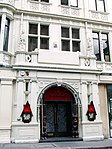The Ritz London is a Grade II listed 5-star hotel in Piccadilly, London, England. A symbol of high society and luxury, the hotel is one of the world's most prestigious and best known. The Ritz has become so associated with luxury and elegance that the word "ritzy" has entered the English language to denote something that is ostentatiously stylish, fancy, or fashionable.The hotel was opened by Swiss hotelier César Ritz in 1906, eight years after he established the Hôtel Ritz Paris. It began to gain popularity towards the end of World War I, with politicians, socialites, writers and actors in particular. David Lloyd George held a number of secret meetings at the Ritz in the latter half of the war, and it was at the Ritz that he made the decision to intervene on behalf of Greece against Turkey. Noël Coward was a notable diner at the Ritz in the 1920s and 1930s.
Owned by the Bracewell Smith family until 1976, David and Frederick Barclay purchased the hotel for £80 million in 1995. They spent eight years and £40 million restoring it to its former grandeur. In 2002, it became the first hotel to receive a Royal warrant from the Prince of Wales for its banquet and catering services. In 2020, it was sold to a Qatari investor.The exterior is structurally and visually Franco-American in style, with little trace of English architecture, and heavily influenced by the architectural traditions of Paris. The facade on the Piccadilly side is 231 feet (70 m), 115 feet (35 m) on the Arlington Street side, and 87 feet (27 m) on the Green Park side. At the corners of the pavilion roofs of the Ritz are large green copper lions, the emblem of the hotel. The Ritz has 111 rooms and 25 suites.
The interior was designed mainly by London and Paris based designers in the Louis XVI style. Marcus Binney describes the great suite of ground-floor rooms as "one of the all-time masterpieces of hotel architecture" and compares it to a royal palace with its "grand vistas, lofty proportions and sparkling chandeliers".
The Ritz's most widely known facility is the Palm Court, which has traditionally hosted the famous "Tea at the Ritz". It is an opulently decorated cream-coloured Louis XVI setting, with panelled mirrors in gilt bronze frames. In 2022, afternoon tea has been served in the hotel’s former Ballroom located in The Ritz Club, on the lower ground floor of the hotel. The hotel has six private dining rooms, the Marie Antoinette Suite, with its boiserie, and the rooms within the Grade II* listed William Kent House. The Rivoli Bar, built in the Art Deco style, was designed in 2001 by interior designer Tessa Kennedy to resemble the bar on the Orient Express.








